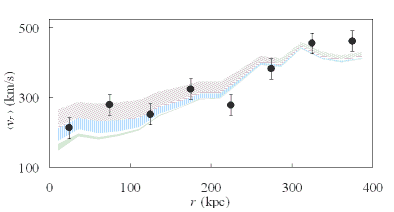The reason why I am concerning myself with more Maxima examples for relativity is that I am learning some subtle things about Brans-Dicke theory and the Parameterized Post-Newtonian (PPN) formalism.
Brans-Dicke theory is perhaps the simplest modification of general relativity. Instead of the gravitational constant, G, the theory has a scalar field φ, and the theory’s Lagrangian now reads
L = [φR − ω∂μφ∂μφ/φ] / 16π.
Here, R is the curvature scalar and ω is an unspecified constant of the theory.
The resulting field equations are just like Einstein’s, except for two things. First, the field equations for the metric now have additional terms containing derivatives of φ; second, there is a new field equation for the scalar field φ that basically says that the d’Alembertian of φ is proportional to the trace of the stress-energy tensor.
Clever people tell you that Brans-Dicke theory is practically excluded by solar system data, as it would only work for insanely high values of ω. They demonstrate this by building approximate solutions for the theory using the PPN formalism, and find that one of the PPN parameters, γ, will have the value of γ = (1 + ω) / (2 + ω); on the other hand, observations by the Cassini spacecraft restrict γ to |γ − 1| < 2.3 × 10−5, so |ω| must be at least 40,000.
Now here’s the puzzling bit: if you solve Brans-Dicke theory in a vacuum, you find that the celebrated Schwarzschild solution of general relativity still applies: keeping φ constant, you just get back this common solution which is known to fit solar system data well, and which has, most importantly, γ = 1 and the value of ω doesn’t matter.
So which is it? Is it γ = 1 or is it γ = (1 + ω) / (2 + ω)? Something is amiss here.
This dilemma can be resolved once you realize that whereas general relativity has a unique spherically symmetric, static vacuum solution, this is not the case for Brans-Dicke theory. This theory has an infinite family of spherically symmetric, static vacuum solutions. Indeed, I think you could actually use the value of γ to parameterize this solution space. However, once you allow some matter into that vacuum, no matter how little, you are locked in to a specific solution, for which γ = (1 + ω) / (2 + ω). In other words, the only vacuum solution that is consistent with the notion of taking the limit of a matter solution by gradually removing matter is NOT the Schwarzschild solution of general relativity, but another, incompatible solution.
This has extremely important implications for our work on MOG. So far, we have obtained a vacuum solution that appears consistent with observations on scales from the solar system to cosmology. However, a recent paper by Deng et al. challenges this work by suggesting that the MOG PPN parameter γ is not 1 and hence, the theory runs into the same trouble as Brans-Dicke theory in the solar system. Is this true? Did we pick a vacuum solution that happens to be inconsistent with matter solutions? This is what I am trying to investigate.




